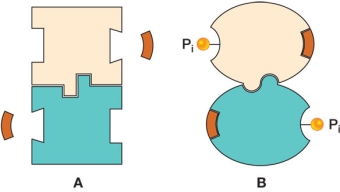Multiple Choice
Figure A shows a protein consisting of two identical subunits.Figure B shows the same protein after each subunit has been covalently modified with a phosphate group.  Based on the activities shown in the diagrams, what biological advantage does this protein gain by having the ability to undergo a reversible phosphorylation-dephosphorylation reaction?
Based on the activities shown in the diagrams, what biological advantage does this protein gain by having the ability to undergo a reversible phosphorylation-dephosphorylation reaction?
A) It gains the ability to resist denaturation.
B) It gains the ability to undergo reversible subunit dissociation.
C) It gains a mechanism for regulating substrate binding.
D) It gains a broader range of molecules that will bind to its binding sites.
E) It gains a broader range of biological functions that it can carry out.
Correct Answer:

Verified
Correct Answer:
Verified
Q11: Refer to the figure below, summarizing how
Q12: Phospholipids are<br>A) nonpolar.<br>B) amphipathic.<br>C) a functional group.<br>D)
Q13: All of the following are examples of
Q14: Refer to the figure showing one of
Q15: Glycogen is all of the following except<br>A)
Q17: In response to low blood sugar, the
Q18: Cholesterol is soluble in chloroform, a nonpolar
Q19: Refer to the figures below. <img src="https://d2lvgg3v3hfg70.cloudfront.net/TB5650/.jpg"
Q20: Refer to the figures below. <img src="https://d2lvgg3v3hfg70.cloudfront.net/TB5650/.jpg"
Q21: Refer to the figure below. <img src="https://d2lvgg3v3hfg70.cloudfront.net/TB5650/.jpg"